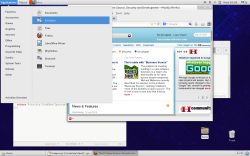Red Hat confirms GNOME Classic Mode for RHEL 7

![]() GNOME 3's Classic Mode under Fedora
GNOME 3's Classic Mode under Fedora
The engineering director for Red Hat Enterprise Linux (RHEL), Denise Dumas, has said that the upcoming version of the company's enterprise Linux distribution will use GNOME 3's Classic Mode by default. Dumas was talking to TechTarget ahead of the 2013 Red Hat Summit that is currently ongoing in Boston. RHEL 7 is scheduled to be released in the second half of this year and Dumas says the decision to use Classic Mode instead of GNOME's default interface, which she calls "modern mode", was made to not inconvenience RHEL's enterprise user base – "the last thing we want to do is disrupt our customers' workflows."
Red Hat's developers have been instrumental in shaping the look and feel of GNOME 3's desktop experience and RHEL's upstream Fedora has been using the desktop environment since the release of Fedora 15 in May 2011. Addressing the efforts of her colleagues, Dumas said: "I think it's been hard for the Gnome guys, because they really, really love modern mode, because that's where their hearts are." She added that the same team had "done a great job putting together classic mode" and that it was eventually decided to use it in favour of the more radical modern interface to spare customers the effort of relearning their way around the desktop again.
Dumas said that, like the redesign of Fedora's and RHEL's Anaconda installer, Classic Mode was developed and refined under user experience testing performed by the company during the last year. Red Hat apparently had much of the direction for RHEL 7 mapped out at the 2012 Red Hat Summit and has spent the intervening time testing its goals against user expectations. These usability tests have most likely also contributed to the decision to not expose customers to GNOME 3's default look as Fedora has done for four versions now. For RHEL customers who wish to try out GNOME's "modern mode", the option to do so is available, of course, and only requires users to change their default GDM session.
Dumas has also said that the company is "making a lot of progress" in being able to support in-place upgrades from RHEL 6 to 7. Upgrading between RHEL versions without having to do a complete reinstall has long been on the wish list of many system administrators and it looks like this might happen for RHEL 7; Dumas did not commit entirely to the option being available, however. Red Hat Software Collections are another administrator-oriented feature that Dumas highlighted, pointing out that these are already available in beta for RHEL 6 and that version 7 will have full support for the feature as well. This year's Red Hat Summit is ongoing and ends Friday.
See also:
- Red Hat's RHEL 7 roadmap, a feature on The H.
(fab)
![Kernel Log: Coming in 3.10 (Part 3) [--] Infrastructure](/imgs/43/1/0/4/2/6/7/2/comingin310_4_kicker-4977194bfb0de0d7.png)

![Kernel Log: Coming in 3.10 (Part 3) [--] Infrastructure](/imgs/43/1/0/4/2/3/2/3/comingin310_3_kicker-151cd7b9e9660f05.png)
















